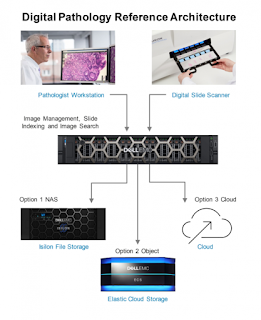Cancer cases on the rise but fewer pathologists
For example, in Europe, the number of cancer cases continues to rise while the number of pathologists is declining with a decreasing percentage of medical graduates choosing to specialise in that area. As a result, the waiting times for patient diagnosis is growing, sometimes taking six to seven weeks to receive results This is not good for patients as it means delaying the start of important treatment.
Technology to plug the gap
While there’s no single panacea to this complex issue, I believe that technology has an important role to play in driving efficiencies as well as freeing up workload. I discussed how IT technology is transforming healthcare by speeding up genome sequencing, leading to faster and more accurate diagnosis. Today, I want to examine the role of digital pathology, machine learning and Artificial Intelligence in modern clinical practice.
The traditional process
We’re all familiar with the traditional process of providing tissue samples for testing. Once collected, the sample is sent by the GP for analysis in a lab, where it’s placed on a glass slide to be examined by a pathologist under a microscope.
When additional opinions are needed, this typically involves the glass slide being transported to another hospital by courier or taxi. Challenges include lost slides in transit, delays in communicating results to patients plus the whole logistical challenge of indexing glass slides and keeping track of where each sample was at any given moment in time. As you can imagine, this isn’t an efficient process. I’ve heard that one pathologist actually wrote his own programme to track where the slides were on their journey!
And, of course, not being able to have all the experts share and comment at the same time is not only inefficient due to the increased time involved in writing and reviewing reports but doctors are also missing the opportunity to react to someone else’s view in real time and have an interactive discussion.
Transforming glass slides into shareable knowledge
The good news is that digital pathology has already disrupted this workflow. Whole-slide imaging, the availability of faster networks, and cheaper storage solutions have made it increasingly easier for pathologists to manage digital slide images and share them for clinical use, enabling real-time consultation and decreasing the time it takes for the patient to receive an accurate diagnosis.
Apart from improving the patient experience, this has proven particularly helpful for smaller hospitals that wouldn’t normally have access to high-quality research expertise. From a training perspective, digital imaging technology also provides a way to preserve, share, duplicate, and study a specimen, benefiting medical researchers, and scientists.
The next stage in digital pathology
However, up until this point, adoption levels have been relatively slow as hospital labs already have microscopes in place and the process of preparing the glass slides prior to scanning still needs to be done. And so, while digitising slides has been a hugely significant development, in many ways, sharing is only half the solution.
What if technology could work with any digitised images, index them and make them searchable? What if Artificial Intelligence could interrogate multiple libraries of images so that when a clinician detected a tumour, the database could be searched to find all similar tumours? The clinician could then evaluate the treatment and subsequent outcomes before designing an effective personalised treatment for the patient.
First-ever image search engine for pathology
The good news is that a new, cost-effective solution – based on standard IT computing, which can run alongside existing scanners and PACS – is now available. Huron Digital Pathology has worked with Dell Technologies OEM | Embedded & Edge Solutions to co-develop a reference architecture, effectively an IT-based appliance solution, which works in conjunction with existing equipment.
The Huron AI-powered image search software solution searches and identifies similar tumours, along with the reports and diagnosis of other pathologists in seconds, giving multiple opinions to aid the pathologist in making a decision. The solution powered by Dell EMC server technology is based on Intel architecture with GPU cards from NVIDIA, complete with a pathologist viewing workstation and Isilon storage.
I believe that this solution will emphatically prove the business case for digital pathology, free-up pathologists to take on additional cases, enable better primary diagnostics, create a platform for more effective multidisciplinary teams. and over the longer-term, enable new breakthroughs in patient treatments.
Looking ahead
This addition of machine learning, and AI to digital pathology is opening the door to new advances in personalised medicine. The ability to mine features from slide images that might not be visually discernible to a pathologist, also offers the opportunity for better quantitative modelling of diseases, which should lead to improved prediction of disease aggressiveness and patient outcomes.
An established player in the US and Canada over the last twenty years, Huron’s goal is to work with Dell Technologies to make digital pathology, machine learning and AI ubiquitous in hospitals and research institutions throughout Europe. Our team is proud to contribute to this development. I believe that this is a great example of how IT technology can be a force for good, driving human progress and making a real difference to society.






0 comments:
Post a Comment